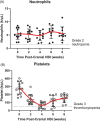Half-Body Radiation Therapy Results in a Prolonged Progression-Free Interval in Canine High-Grade Lymphoma After First Remission
- PMID: 40088118
- PMCID: PMC12082781
- DOI: 10.1111/vco.13050
Half-Body Radiation Therapy Results in a Prolonged Progression-Free Interval in Canine High-Grade Lymphoma After First Remission
Abstract
An optimal protocol of adding wide-field irradiation to multi-agent chemotherapy for dogs with lymphoma has not been established. The aim of this retrospective case-control study was to evaluate the efficacy of a protocol combining chemotherapy and half-body irradiation (HBI) for dogs with high-grade lymphoma. Dogs in the treatment group received cranial HBI 2 weeks after completing the second cycle of the multi-agent chemotherapy protocol. The radiation therapy protocol consisted of 4 Gy/fraction once per day for 2 consecutive days for the cranial half body, followed by the same protocol for the caudal half 2 weeks later. The control group only received multi-agent chemotherapy. All patients were required to have cytological confirmation of high-grade lymphoma and achieve complete remission after two cycles of multi-agent chemotherapy. Fourteen patients receiving HBI and 11 patients in the control group were included. The median progression-free interval (PFI) in the HBI group (1143 days) was significantly longer than that in the control group (316 days, p = 0.004). In the HBI group, dogs with T cell lymphoma had statistically shorter PFI (292 days) than dogs with B cell lymphoma (2127 days, p = 0.0013). The median survival time in the HBI group (1924 days) was significantly longer than that in the chemotherapy-only group (566 days, p = 0.0077). The predictive factors for longer PFI and ST were found in the patients who received HBI and chemotherapy (p = 0.0062 and 0.0252, respectively). For chemotherapy-responding patients that completed a multi-agent protocol, HBI significantly prolonged the time to tumour relapse compared with the chemotherapy-only group.
Keywords: canine lymphoma treatment; case–control study; chemotherapy responders; combination therapy; lymphoma radiation; novel half body radiation therapy protocol.
© 2025 The Author(s). Veterinary and Comparative Oncology published by John Wiley & Sons Ltd.
Conflict of interest statement
The authors declare no conflicts of interest.
Figures


References
-
- Sorenmo K., Overley B., Krick E., Ferrara T., LaBlanc A., and Shofer F., “Outcome and Toxicity Associated With a Dose‐Intensified, Maintenance‐Free CHOP‐Based Chemotherapy Protocol in Canine Lymphoma: 130 Cases,” Veterinary and Comparative Oncology 8, no. 3 (2010): 196–208. - PubMed
-
- Brown P. M., Tzannes S., Nguyen S., White J., and Langova V., “LOPP Chemotherapy as a First‐Line Treatment for Dogs With T‐Cell Lymphoma,” Veterinary and Comparative Oncology 16, no. 1 (2018): 108–113. - PubMed
-
- Brodsky E. M., Maudlin G. N., Lachowicz J. L., and Post G. S., “Asparaginase and MOPP Treatment of Dogs With Lymphoma,” Journal of Veterinary Internal Medicine 23, no. 3 (2009): 578–584. - PubMed
-
- Chun R., Garrett L. D., and Vail D. M., “Evaluation of a High‐Dose Chemotherapy Protocol With no Maintenance Therapy for Dogs With Lymphoma,” Journal of Veterinary Internal Medicine/American College of Veterinary Internal Medicine 14, no. 2 (2000): 120–124. - PubMed
-
- Vail D. M., Pinkerton M., and Young K. M., “Hematopoietic Tumors, Chapter 33,” in Withrow and Macewen's Small Animal Clinical Oncology, 6th ed., ed. Vail D. M., Thamm D. H., and Liptak J. M. (Elsevier, 2020), 688–772.
MeSH terms
LinkOut - more resources
Full Text Sources
Medical

